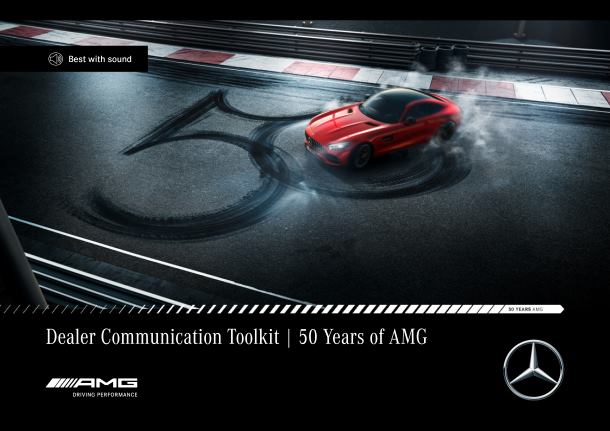- To mark its half-century, Mercedes-AMG calls on South Africa to imitate its distinctive engine growl
After 50 years of Driving Performance, Mercedes-AMG has given the world one distinctly recognisable voice: the signature growl of the AMG engine. To mark AMG’s 50th anniversary, the brand is calling on South Africans to imitate this iconic sound on Instagram, Facebook, Twitter or any other social media channel, tagging Mercedes-Benz South Africa and using the hashtag #AMGgrowl.
To kick off the campaign, Mercedes-AMG has compiled videos featuring their ‘Friends of the Brand’, including fashion designer David Tlale; musician J’Something of Mi Casa; TV personality Jeannie D and environmentalist Kevin Richardson and others, doing their best interpretation of the distinctive growl.
In total, eight videos prepared by the ‘Friends of the Brand’ are being released online by Mercedes-AMG during August – inspiration for AMG fans to add their own growl to the collection. The videos – both those released by the brand and those posted by fans – will pay homage to AMG over the years.
“South African’s have shown us just how much they love our AMG cars, especially the iconic and visceral sound exhaust note, and this is why we plan to also profile our fans doing the growl, while highlighting the inherent beauty of our AMG range. It’s a celebration of Driving Performance as well as a ‘thank you’ to all who hold our brand close to their hearts,” says Selvin Govender, Marketing Director, Mercedes-Benz Cars.
“Mercedes-AMG consistently leads the luxury performance and sports segments with record sales, significantly contributing to Mercedes-Benz holding the Number One spot for the year, both locally and globally,” adds Govender.
The campaign will culminate at the Festival of Motoring, being held at the Kyalami Race Track from 1-3 September, where the brand will profile some of the fan videos alongside the latest AMG vehicles, including the new Mercedes-AMG GT R and AMG GT C.
“AMG has, over its half-century of existence, come to stand for supreme automotive performance, exclusivity, efficiency and highly dynamic driving enjoyment, repeatedly confirming its position as a highly successful sports car and performance brand,” concludes Govender.
The brand promise of “Driving Performance” encompasses its core strengths: cutting-edge technology and a passion for dynamic, emotively appealing products. The company stands worldwide for outstanding engine expertise. AMG remains true to its “one man, one engine” philosophy, which means that each engine is hand-crafted by one engineer.
A few key milestones in the 50-year journey include;
1967: AMG is founded in Burgstall by Hans-Werner Aufrecht and Erhard Melcher as an “engineering office, design and testing for the development of racing engines”.
1971: AMG becomes famous overnight, with the AMG 300 SEL 6.8 winning its class at the Spa‑Francorchamps 24‑hour race and finishing second overall.
1976: The plant in Affalterbach is founded and the racing engine workshop evolves into a manufacturer of sports saloons and coupés.
1984: Melcher independently develops a cylinder head with modern four-valve technology for use in the 5‑litre V8 in the Mercedes-Benz 500 SEC. The ongoing principle of “one man, one engine” is cemented into the brand’s lexicon.
1986: The new cylinder head is used in the AMG version of the S‑Class and also in the saloon and, from 1987, in the coupé of the mid-size class (W124). Rated at 265 kW, the car is christened “The Hammer” by American motoring media.
1988: AMG begins constructing Mercedes-Benz 190 E racing cars and is also responsible for their deployment in the German Touring Car Championship (DTM).
1990: Collaboration with Mercedes-Benz begins.
1991: AMG embarks on the development and production of sports versions of Mercedes-Benz vehicles.
1993: The C 36 AMG is the first vehicle on the market to result from the collaboration agreement with Daimler-Benz. With sales of 5,000 units up to 1997, it becomes the first best-seller.
1996: The C 36 AMG is the first official Formula 1 safety car.
1999: DaimlerChrysler owns a 51% share in Mercedes-AMG.
2001: The newly developed 5-speed automatic transmission in the C 32 AMG is paired with the 3.2‑litre supercharged V6, with innovative touch control enabling manual gear selection as well.
2005: Mercedes-AMG becomes a wholly-owned subsidiary of Daimler AG.
2009: The Mercedes-Benz SLS AMG is the first vehicle to be developed entirely in-house. The sound, along with uncompromising driving dynamics and iconic gull-wing doors, found fans around the world.
2011: AMG branches into motor racing with the SLS AMG GT3. The SLS GT3 marks Mercedes-Benz’ entry into exclusive customer racing.
2014: The Mercedes-AMG GT is the second sports car to be developed entirely in-house by Mercedes-AMG in Affalterbach. With its entry into the compact segment and its 43 series vehicles, AMG widens its portfolio while winning new groups of customers.
2015: Mercedes-AMG sets a new sales record with almost 70,000 units. The growth drivers include the new 43 series models and, above all, the performance vehicles of the C‑Class, SUVs and compacts.
2016: The Mercedes-AMG GT3 writes a new chapter in the history of customer sports. At the ADAC Zurich 24-hour race at the Nürburgring, the first four places went to teams competing in the Mercedes-AMG GT3.
2017: With almost 100,000 units, Mercedes-AMG celebrates its 50th anniversary on the back of a new sales record. With the AMG GT C, Mercedes-AMG extends its sports car portfolio to six models plus the customer sports AMG GT3 racing car. This is the second vehicle developed entirely in-house in under three years.
